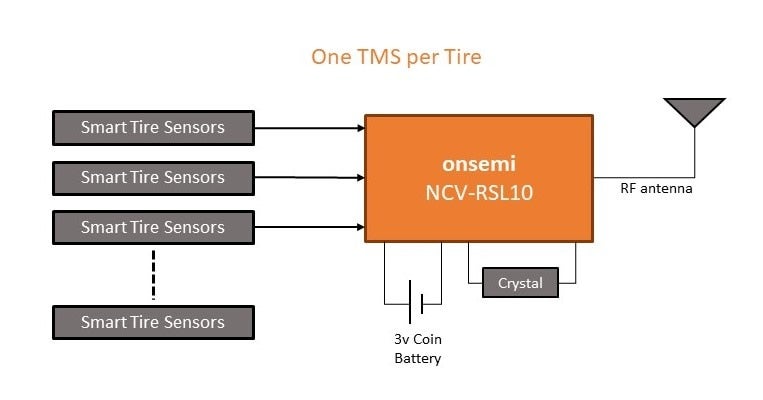Modern vehicles are equipped with tire pressure monitoring systems (TPMS) thanks to the Transportation Recall Enhancement, Accountability, and Documentation (TREAD) Act. Monitoring tire pressure can alert drivers to sudden or gradual pressure loss to avoid accidents and identify issues related to tire wear. Tire and auto manufacturers want to monitor much more than just tire pressure. In addition, acceleration and angular motion could be monitored and compared against the vehicle motion and against the other tires to adjust for safety reasons or even ride comfort, for instance, providing a real benefit to the vehicle owner. Because the temperature and many other real-time variables, such as tire wear, are increasingly being monitored, the shortened acronym of TMS, for Tire Monitoring System, is now fitting. Although “less is more” concerning the acronym, when it comes to functionality, more is required from the system components to sense, process, store and transmit all this new data.
The list of sensors and general functionality continues to grow; however, the power consumption budget has not increased. As a rule, there’s one sensor system per tire or wheel. Some factory TMS are integrated into the wheel’s valve stems, while some aftermarket systems are mounted inside the tire on the rubber surface. These systems are small, coin-cell battery-powered units that communicate wirelessly to a central body computer or central processing unit and sometimes via Bluetooth® Low Energy to your smartphone. In any case, these systems are becoming more complex, with more sensors capturing more data, and, as a result, have become more power-hungry over time. With the battery often embedded in the tire itself, an average person cannot swap out the battery like you can with your key fob.
One of the most common reasons for TMS system failure, when the nagging “Service Tire Monitoring System” or similar message appears, usually indicates one of the sensor’s batteries has depleted. If one has failed, for this reason, the others will follow soon. It’s time to get your vehicle serviced for some replacements.
Many sensors, plentiful data, wireless transmission, and often 10-year battery life make for challenging design requirements. What about security? Security in TMS will not prevent someone from stealing your tire (at least not yet), but it should protect against unauthorized wireless access to the vehicle’s central body computer or central processing unit. Worse things than losing a tire can happen with unauthorized access to the vehicle computer. The need for security has become a standard system requirement which means the system must have updateable software to patch future security vulnerabilities.
The trick in systems such as Passive Entry Passive Start (PEPS) is to use as little power as possible, and conserving battery energy equates directly to increased product longevity. Partron has designed a TMS system for Hankook Tire using onsemi’s industry-leading low-power consumption NCV-RSL10 Bluetooth Low Energy-enabled microcontroller (MCU). Don’t take our word for it, though. Check out the EEMBC’s ULPMark-CoreProfile benchmark scores for yourself. As of this writing, the RSL10 remains the leader, scoring 1260 at 2.1 V, and a close 2nd is our RSL15.
Figure 1. EEMBC ULPMark-CoreProfile Scores
Being known for providing the longest battery life in the industry among the more sophisticated Bluetooth Low Energy-enabled MCU cores that support firmware over-the-air (FOTA) updates, the NCV-RSL10 is taking flight – or maybe better said, hitting the road. Along with a comprehensive software offering and 24/7 development community support, we also make it easy to design-in.
Figure 2. A Typical TMS System Block Diagram (tire side)
On the softer side, onsemi’s position and relationships with the ecosystem’s sensor manufacturers and our application engineering support were among the reasons we earned this opportunity beyond the ability to manage power consumption better than the competition. That’s important as TMS is new, and the requirements are still expanding. Therefore a more sophisticated wireless MCU is required and potentially one that even supports FOTA to address your future security needs.
onsemi is gearing up for CES 2023 and will showcase the abovementioned NCV-RSL10-enabled TMS system at our booth. Please come look for yourself and experience what we bring to the table … or road. Find us at Murano #3302 at Venetian Expo from January 5 to 8, 2023. Learn more about using NCV-RSL10 for your automotive applications. Click here to contact our sales support team and discuss our technology solutions or schedule an in-person meeting.


